Pokhara is a vibrant lakeside city in the Annapurna Region. Located on the banks of the serene Phewa Lake, it is one of the most popular tourist destinations in Nepal.
The city lies in a verdant valley graced with natural wonders like the jewel-like Phewa Lake, the Seven Leknath Lakes, Gupteshwar Mahadev Cave, and the picturesque hills, which serve as a lookout point for panoramic mountain views. The valley offers ample opportunities for thrilling outdoor activities like hiking, paragliding, boating, kayaking, mountain biking, bungee jumping, skydiving, etc. There’s so much to see and do in the city that one never gets bored while in Pokhara.
Renowned as the gateway to the Annapurna Sanctuary (Annapurna Base Camp) and Annapurna Circuit, Pokhara is a hub for trekking and adventure tourism. Each year it attracts thousands of travelers seeking to explore the Himalayan mountains. Most treks to the Annapurna Region begin with a ride from Pokhara to the specific trailhead.
Pokhara is also home to the brave Gurkha soldiers, whose courage and valor are renowned all over the world. The lakeside city effortlessly blends natural beauty, cultural richness, and adventure, making it one of Nepal’s top holiday destinations.
Climate of Pokhara: Pokhara Weather for 10 days
Pokhara sits at an elevation of 822 meters above sea level and has a pleasant subtropical climate. While it can be humid during the summer months, the weather remains pleasantly warm for the rest of the year.
January is the coldest month in Pokhara, and June is the hottest. During January, the temperature hits a low of 7.1°C. Spring, autumn, and winter seasons are pleasant, while summer can be hot, humid, and wet. In June, the mercury rises above 35°C, making the air hot and humid.
The monsoon season, from June to September, brings significant rainfall, with July being the wettest. Pokhara receives an average rainfall of 940mm during the monsoon season. This heavy precipitation is due to Pokhara's proximity to the Annapurna Range, which influences moisture-laden winds to release rainfall over the region. Within Pokhara, rainfall distribution varies, with the northern areas at the foothills receiving more precipitation than the southern parts near Phewa Lake. Notably, Lumle, which lies about 40 km from Pokhara, records the highest annual rainfall in Nepal, exceeding 5,600mm.
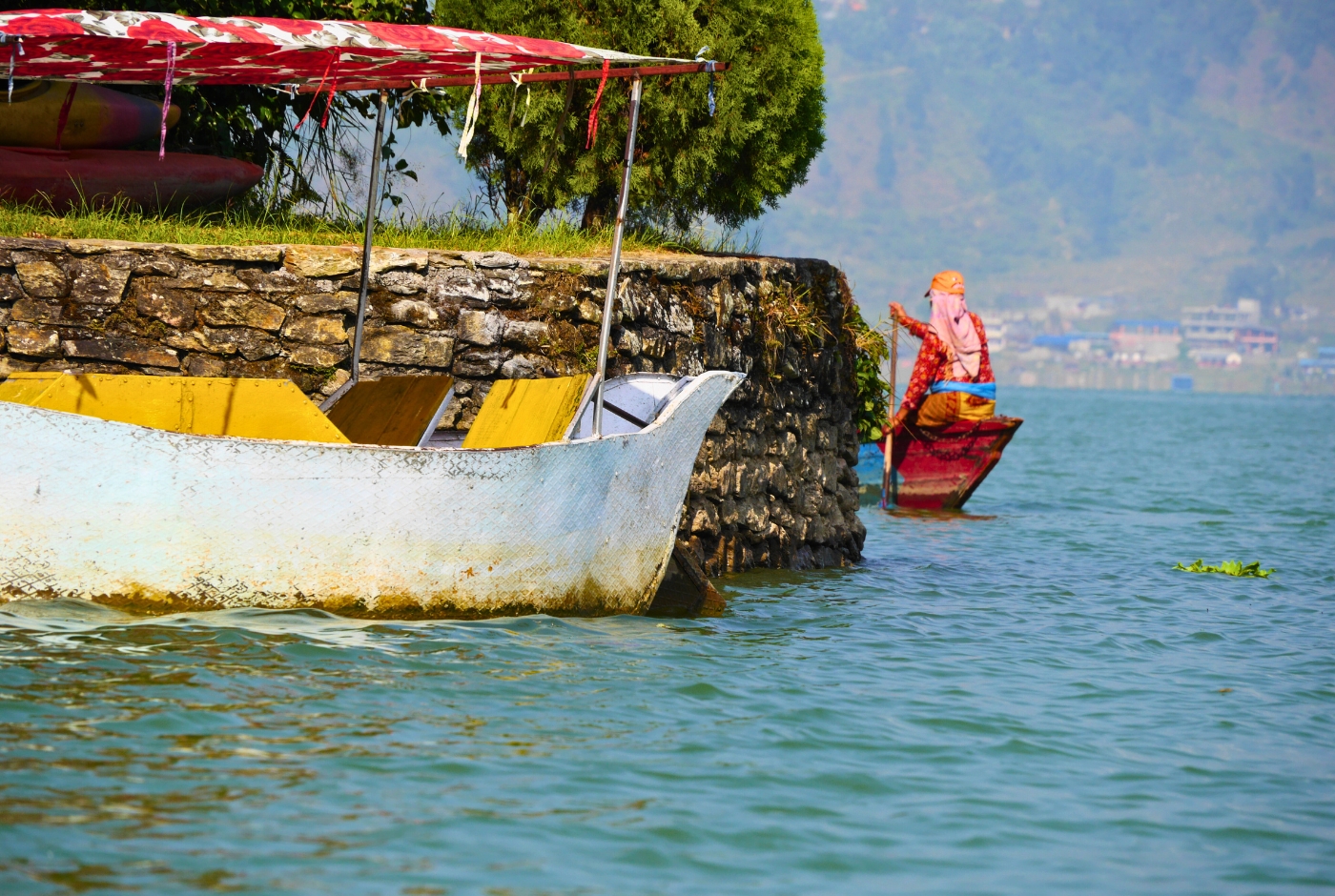
Summers can be humid and hot, with average temperatures ranging from 25°C to 35°C, while weather in winter remains mild, with temperatures hovering between -2°C and 15°C. In contrast, Kathmandu, situated at a higher altitude, generally experiences cooler temperatures than Pokhara.
For those planning a visit, the period from October to March is ideal. During these months, the weather is generally clear and mild, offering unobstructed views of the Himalayan peaks and comfortable conditions for outdoor excursions.
How to reach Pokhara from Kathmandu?
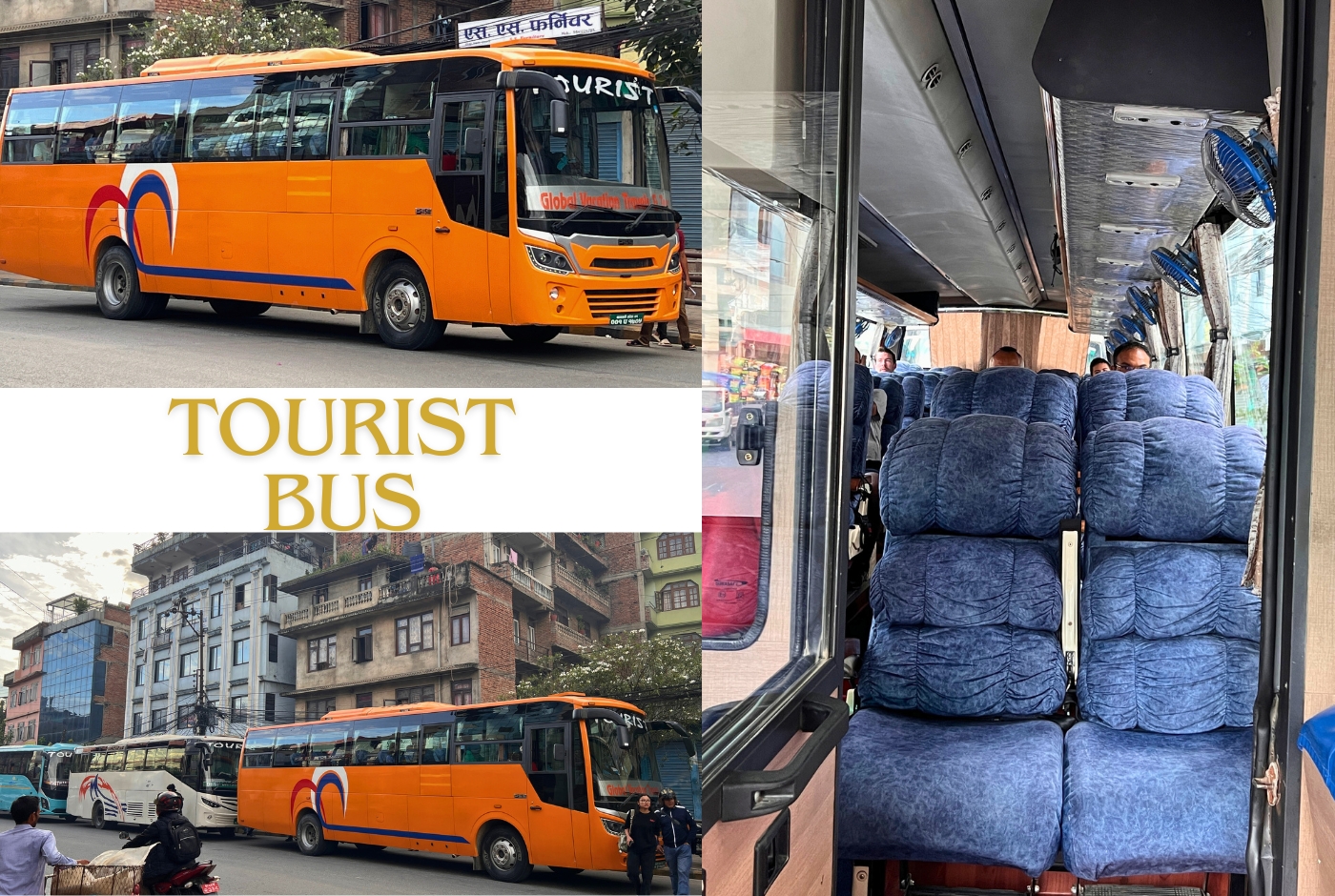
To reach Pokhara from Kathmandu, you can either take a flight or an overland journey. It will take around 25-30 minutes to reach Pokhara by air, while the journey by road is longer and will take 7-8 hours to complete. As of 2025, the highway between Pokhara and Kathmandu is under construction, and the drive between these two cities won’t be comfortable.
If you are short on time and can afford to pay for the flight, you can fly directly to Pokhara from Kathmandu. This will be more convenient, comfortable, and time-saving. Flights to Pokhara leave daily from the domestic airport in Kathmandu. Yeti Airlines, Buddha Air, Shree Airlines, and Saurya Airlines are the major airlines operating flights between these two major cities. While pricier than road transport, Pokhara flights offer scenic aerial views of the Himalayas.
You can also hire a private vehicle or taxi and drive to Pokhara. However, this will be much costlier than taking a flight. But for those seeking flexibility, hiring a private car, jeep, or van can reduce the travel time to 5–7 hours, depending on road conditions and number of stops en route. A luxury tourist bus can be a cheaper option with fares ranging from NPR 1600 to 2500 per person. Luxury buses bound for Pokhara depart daily from Jamal and Balaju areas. These buses offer comfortable seating, AC, WiFi, and complimentary meals.
If you are on a tight budget, then you can consider traveling via local buses and microbuses. These buses operate from Gongabu Bus Park and take about 7–9 hours to reach the destination. While the fares are cheaper, these buses can be uncomfortable and crowded. The local buses also do not have fixed schedules and usually run late.
Pokhara International Airport: A Guide for Trekkers
Pokhara International Airport is the main gateway for trekkers heading to the Annapurna and Mustang regions. Located just 3 km east of the old domestic airport, it provides improved access to key trekking destinations.
Getting to the Airport
- From Lakeside Pokhara: About a 15-minute drive via taxi or local transport.
- Bus and Taxi Access: The airport is connected to the city via buses and taxis, making it easy for trekkers to reach their accommodations.
Flight Information for Trekkers
- Domestic Airlines Operating from Pokhara: Buddha Air, Yeti Airlines, Saurya Airlines, Shree Airlines, and Sita Air operate flights to and from Kathmandu.
- Jomsom Flights: Flights to Jomsom are operated from the old domestic airport in Pokhara.
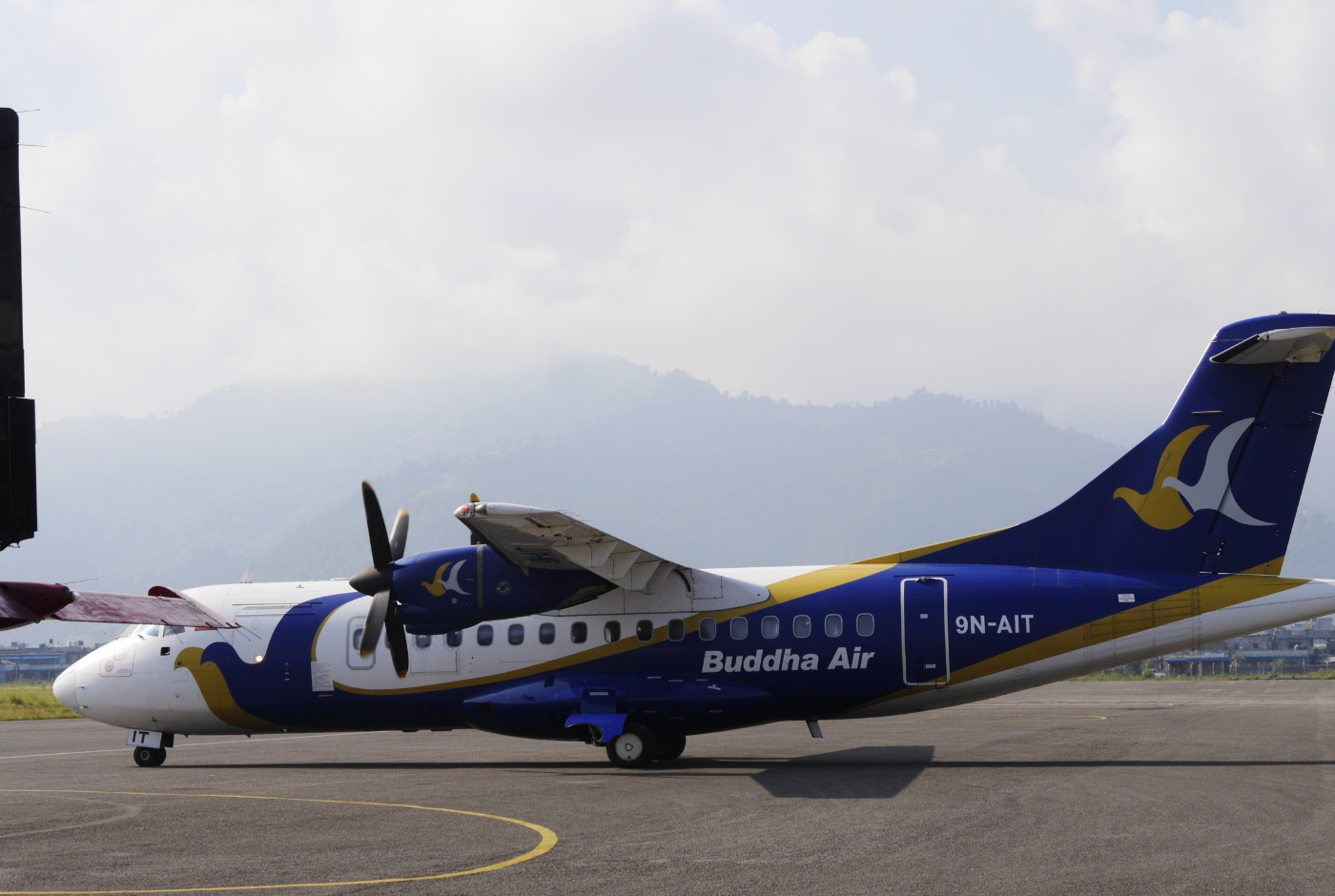
International Routes:
China’s Sichuan Airlines operates charter flights between Chengdu and Pokhara, while Himalaya Airlines has introduced flights between Lhasa and Pokhara.
Facilities for Trekkers
- Two Terminals—Separate domestic and international terminals, ensuring smoother transit.
- Cargo and Baggage Handling—Trekking gear and baggage can be managed efficiently, but trekkers should confirm with airlines about baggage limits.
- Limited International Flights—As of April 2025, there are limited international flights, and most trekkers still need to transit through Kathmandu’s Tribhuvan International Airport (TIA).
- Closest Airport to Annapurna and Mustang—Trekkers heading to Annapurna Base Camp, Ghorepani Poon Hill, Mardi Himal, or Mustang can start their journey from here.
- Domestic Flight Connectivity—Regular flights connect Pokhara to Kathmandu, reducing travel time compared to long road journeys.
However, trekkers flying to and from Jomsom should note that flights to Jomsom (for Upper Mustang and Muktinath) operate from the old Pokhara Airport and not from the new Pokhara International Airport.
Distance from Kathmandu to Pokhara and other notable places
While traveling from Kathmandu to Pokhara by road, you will cover an approximate distance of 200 kilometers (124 miles), typically taking 6–8 hours. If you take a flight, it will take around 25–30 minutes to fly from Kathmandu to Pokhara.
Pokhara is the gateway to most of the popular treks in the Annapurna Region, and from here you can easily access the trailheads of popular treks.
Nayapul: A bustling riverside town and one of the oldest trailheads in the Annapurna Region, Nayapul lies about 42 kilometers (26 miles) from Pokhara. Before the new mountain roads were built, most trekkers heading to Ghorepani Poon Hill, ABC, or the Annapurna Circuit used to start their trek from Nayapul. However, with the building of new jeep tracks, it’s possible to drive further up to the trail, thus cutting down on the duration of the trek. Vehicles can now reach up to Birethanti, Ghandruk, and Chamje. Nowadays only a handful of trekkers prefer to use Nayapul as the base for their trek.
Birethanti: Birethanti lies a short walk away from Nayapul, across the bridge. This is the first point where foreign trekkers have their trekking permits checked. Those who like to take the old route to Ghorepani or ABC start their trek from here.
Ulleri: Ulleri is another major stopover point on the Ghorepani Poonhill trekking route. One has to climb 3,300 steps from Hille to reach Ulleri. However, with the building of the new road, one can drive to Ulleri straightaway and skip climbing the long and tiring staircase.
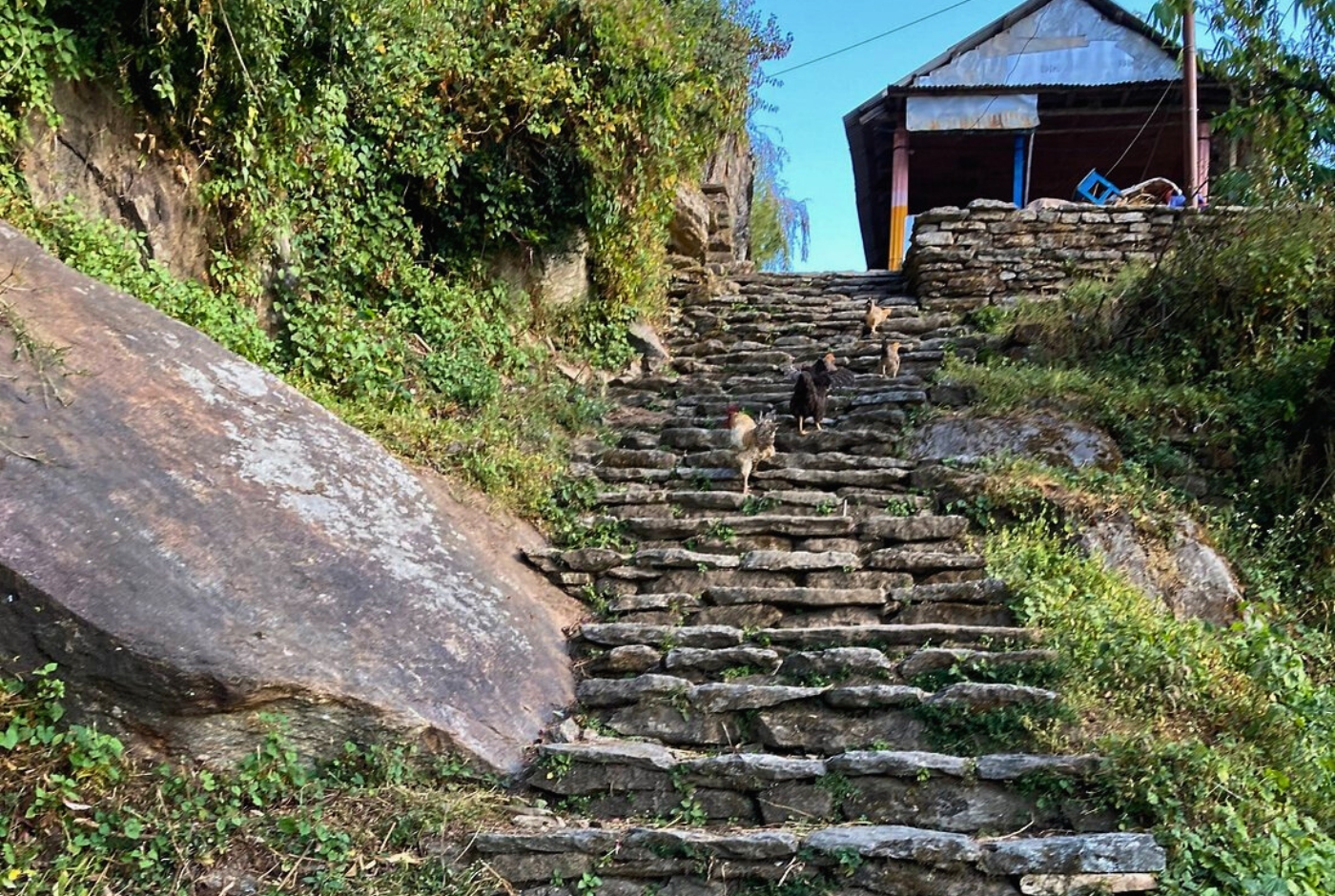
Ghorepani: Ghorepani is a large Magar settlement at the base of Poon Hill. It used to be a pit stop for travelers, caravans, and traders walking along the old Salt Trade Route in the olden days. But now only locals and foreign trekkers walk along this route. Continuing from Ulleri, Ghorepani is an 8-kilometer (5 miles) trek, usually requiring 5–6 hours. Now one has the option to skip the trek to Ulleri,. One can now drive straight to Banthanti from Pokhara and begin one's trek to Ghorepani. It takes only 3-4 hours to trek to Ghorepani from the jeep park at Banthanti.
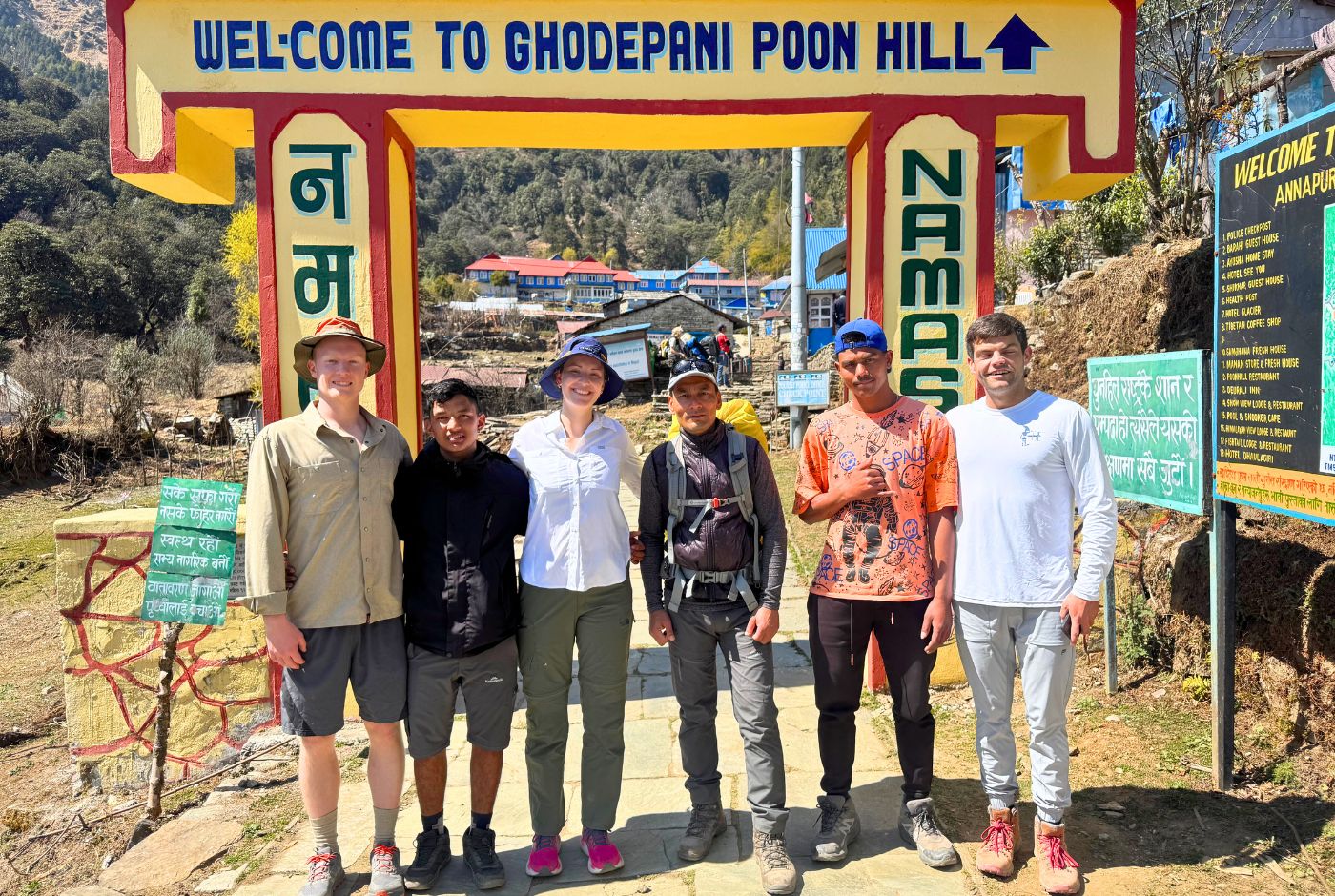
Poon Hill: Poon Hill is one of the most popular Himalayan sunrise viewpoints in the Annapurna Region. The hill lies close to Ghorepani, approximately 1.5 kilometers (0.9 miles) from the bustling settlement. Poon Hill can be reached by hiking uphill for about an hour or more. The vantage point lies at an elevation of 3210 meters, and one can enjoy a panoramic 360-degree view of the Himalayan mountains (Annapurna South, Nilgiri Himal, Dhaulagiri, Hiunchuli, Gangapurna, Annapurna Fang, Tukuche Himal, Machapuchhre, Annapurna I, II, IV, etc.).
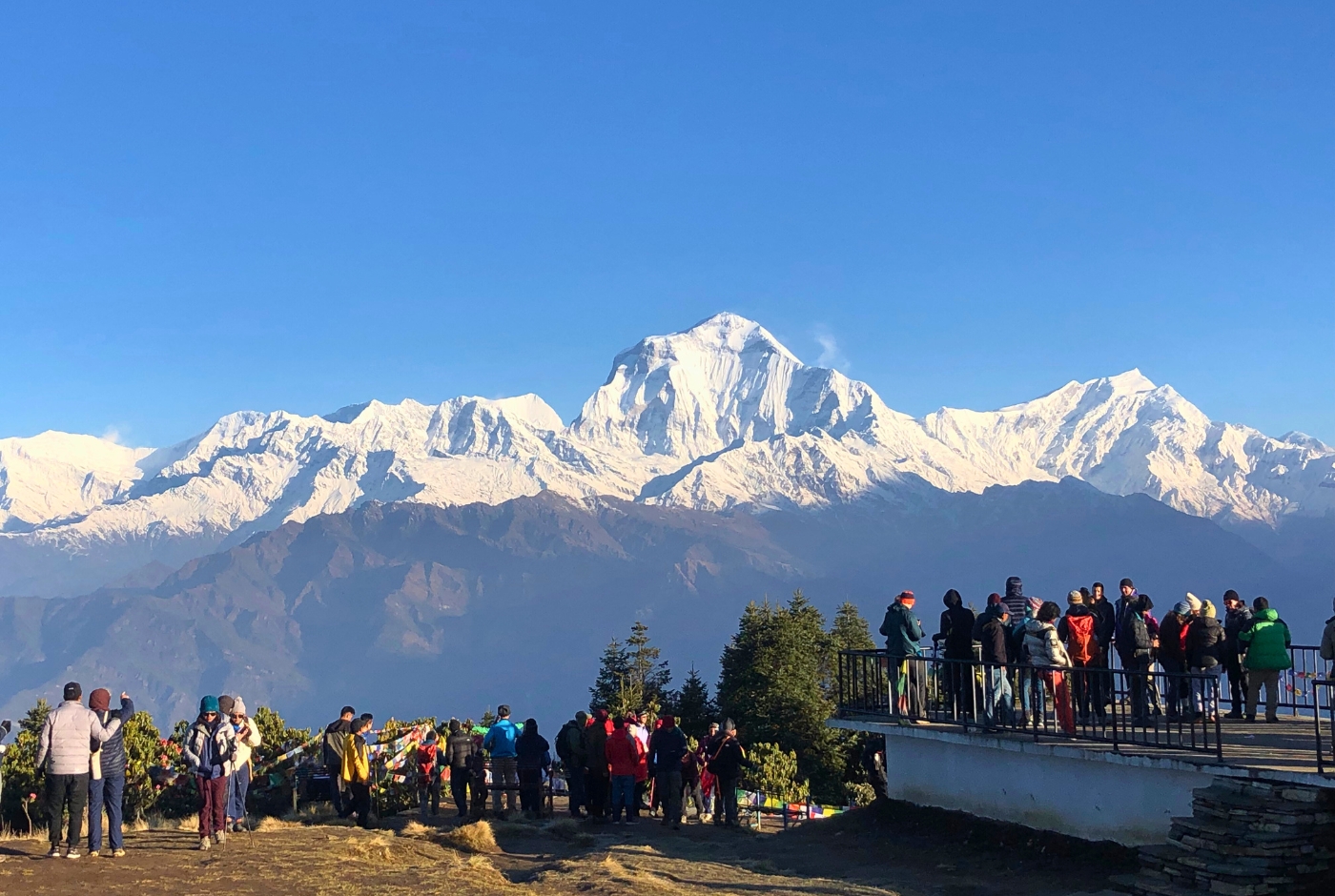
Tadapani: Tadapani is a beautiful Gurung settlement that lies nestled amidst one of the biggest rhododendron forests in the world. From Ghorepani, it takes about a 6–7-hour trek to cover the 11.2-kilometer (7 miles) distance between Ghorepani and Tadapani. The village of Tadapani also offers mesmerizing views of peaks of Nepal like Machhapuchre (Fishtail Peak), Dhaulagiri, and Annapurna South. The trek to Tadapani is really picturesque during spring as the trail is covered with colorful pink and red rhododendron blooms.
Ghandruk: Ghandruk is an ancient Gurung village filled with quaint traditional stone cottages and narrow alleys. It is part of the Gurung Heritage Trail and offers trekkers an insight into Gurung culture and traditions. The scenic village sits on the side of a steep hill and offers stunning views of Annapurna South, Gangapurna, and Machapuchhre. It takes about 5-6 hours (8.8 kilometers/5.5 miles) to trek from Tadapani to Ghandruk. Trekkers walking along the Annapurna Base Camp and Ghorepani Poon Hill route prefer to spend a night at this beautiful village at the beginning or end of their trek.
Kimche: In recent years Kimche has become the starting point for most treks in the Annapurna Region. Trekkers heading to ABC now prefer to start their trek from Kimche instead of Ghandruk. Kimche lies below Ghandruk, and one can skip getting to the village of Ghandruk and join the ABC trail from Kimche. The distance between Ghandruk and Kimche is 2–3 kilometers (1.2–1.9 miles). It takes less than 2 hours to walk to Kimche from Ghandruk. From Pokhara, it takes about 2-3 hours to drive to Kimche.
Lumbini: Lumbini, a town lying in the Terai plains, is a famous Buddhist pilgrimage site. It is the birthplace of Lord Buddha and a sacred pilgrimage destination for Buddhists. A protected UNESCO World Heritage Site, Lumbini is dotted with ancient temples and new monasteries built by the Buddhist countries.
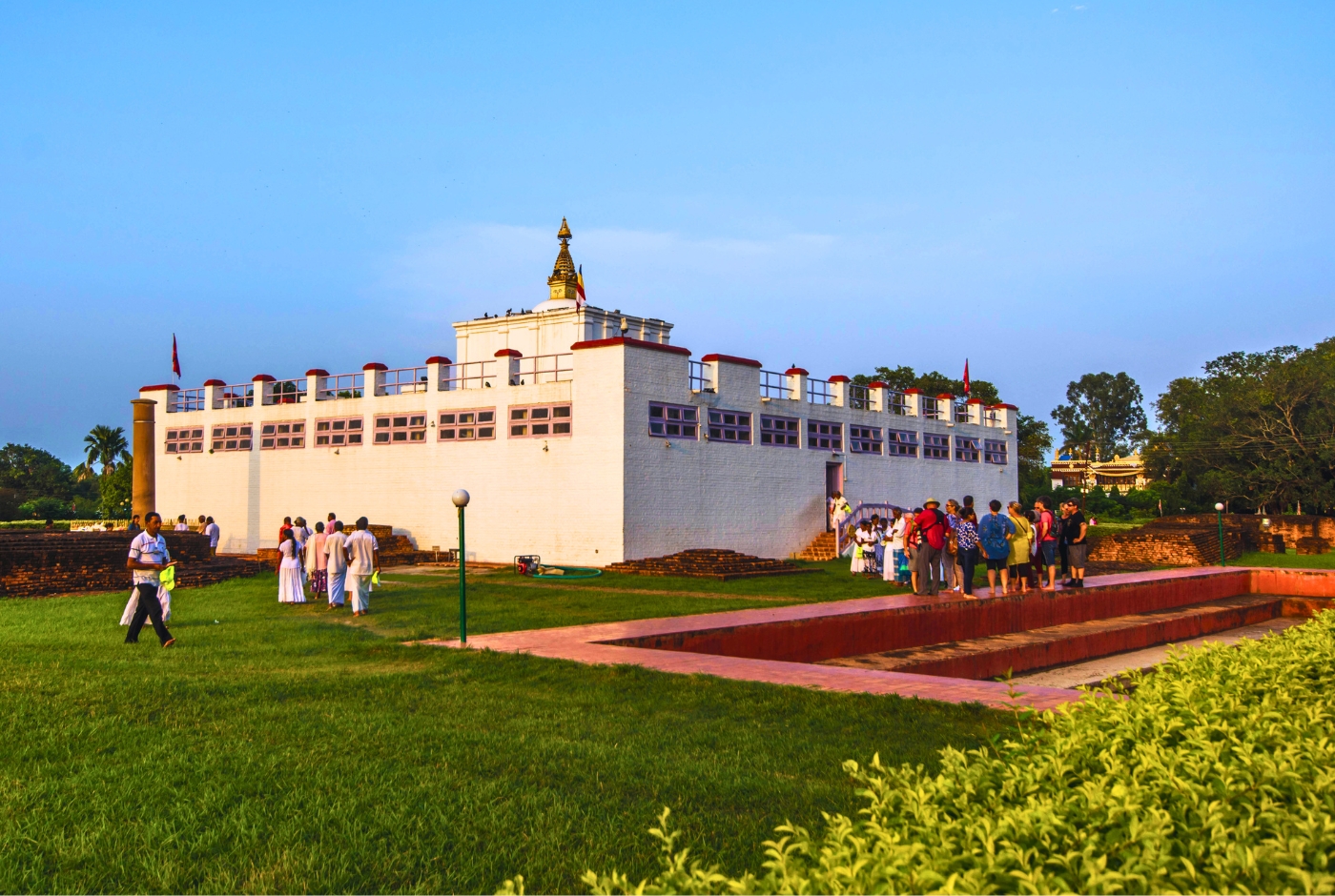
The distance between Lumbini and Pokhara is approximately 150 to 200 kilometers (93 to 124 miles). Depending on the route you choose, it could take anywhere between 5 to 6 hours to drive to Lumbini from Pokhara. From Kathmandu, it takes around 6-7 hours to reach Lumbini by road. The nearest airport is the Gautam Buddha International, which lies about 19 kilometers from Lumbini’s World Heritage Site.
Chitwan: Chitwan is famous for its national park, which is home to several endangered species of flora and fauna. Spread over an area of 952.63 sq. km., the national park is home to the one-horned rhinoceros, Royal Bengal tiger, crocodiles, wild elephants, antelopes, etc.
The Chitwan National Park is quite popular among tourists for the thrilling wildlife activities it offers. Located close to both Kathmandu and Pokhara, tourists who love wildlife explorations prefer to add Chitwan National Park to their Nepal tour itinerary. From Pokhara to Chitwan, the distance is approximately 147 kilometers (91 miles), while the distance between Kathmandu and Chitwan is approximately 155 kilometers.
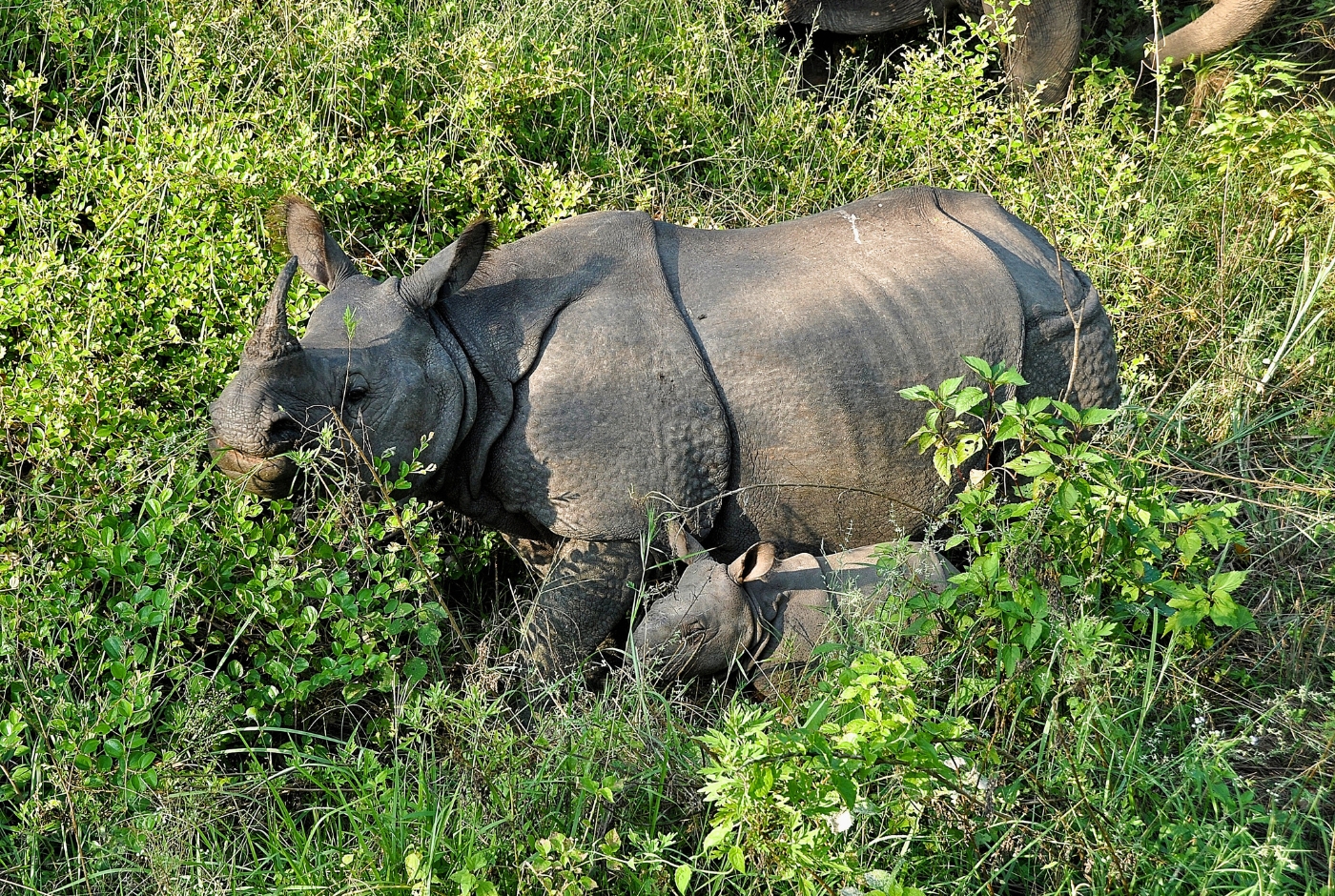
These distances and times are approximate and can vary based on individual pace, weather conditions, and specific routes taken.
The five best places to visit in Pokhara
Phewa Lake
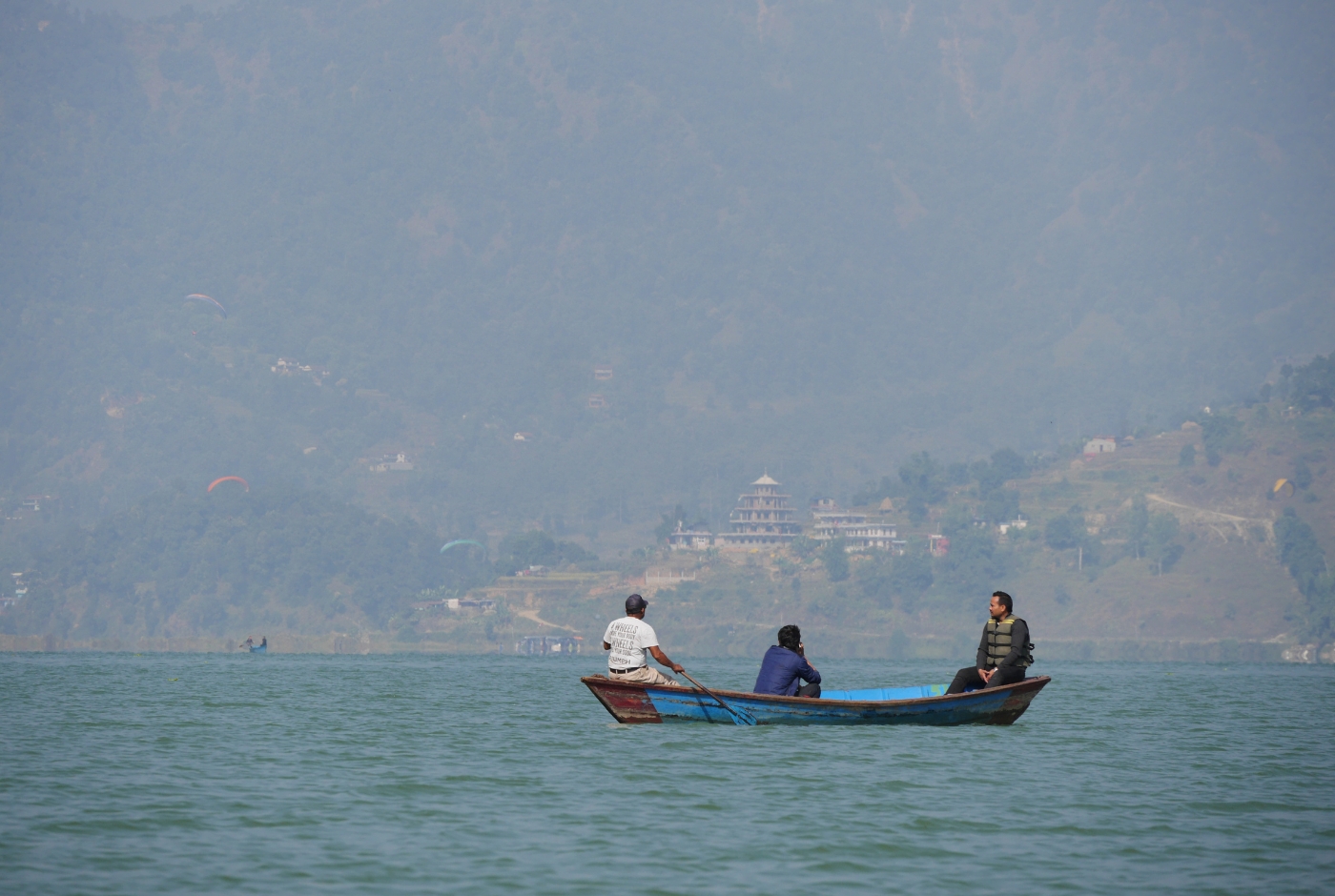
Phewa Lake, also known as Fewa Taal, is a beautiful freshwater lake located in Pokhara Valley. It is one of the most recognized landmarks in the city. Phewa Lake is renowned for its serene ambiance and the stunning reflections of the Annapurna and Dhaulagiri Mountain ranges on its calm waters. The lake is surrounded by a densely forested shore with lots of birds.
Phewa Lake holds the distinction of being the second-largest lake in the country and the largest lake in Gandaki Province. Situated at an elevation of approximately 742 meters, the lake covers an area of about 5.7 square kilometers, with an average depth of 8.6 meters and reaching a maximum depth of 24 meters.
In terms of dimensions, Phewa Lake stretches approximately 4 kilometers in length and 2 kilometers in width. The lake's ecosystem supports various activities, including commercial cage fisheries. The outflowing water from the lake is utilized for hydroelectric power generation at the Phewa Power House, located about 1.5 kilometers from the lake's southern end.
The lakeside area, commonly referred to as Baidam, is a vibrant tourist hub. Lots of hotels, restaurants, and shops catering to the diverse needs of visitors line the lakeside area. Boating on Phewa Lake is a popular activity among tourists. One can enjoy beautiful views of the hills and snow-capped mountains while boating on the serene lake.
One can also visit the Tal Barahi Temple, a two-storied pagoda temple situated on an island in the middle of the lake. This temple is a hub for Hindu religious activities, especially on Saturdays when devotees gather in large numbers to offer prayers to the island’s deity.
For those interested in exploring Phewa Lake, the boating prices vary depending on the type of boat and duration of the boat tour. Visitors can choose between guided tours or self-rowing options, with rates differing accordingly.
Phewa Lake serves as the starting point for popular day hikes, making it a favored spot for hikers. One can take a boat across the lake and start the hike to Peace Stupa from the lake’s shore.
The lake's tranquil environment, combined with the majestic backdrop of the Himalayas, makes it a cherished destination for both domestic and international travelers. Whether one is seeking spiritual solace at the Tal Barahi Temple or simply a peaceful retreat, Phewa Lake offers a harmonious blend of nature and culture.
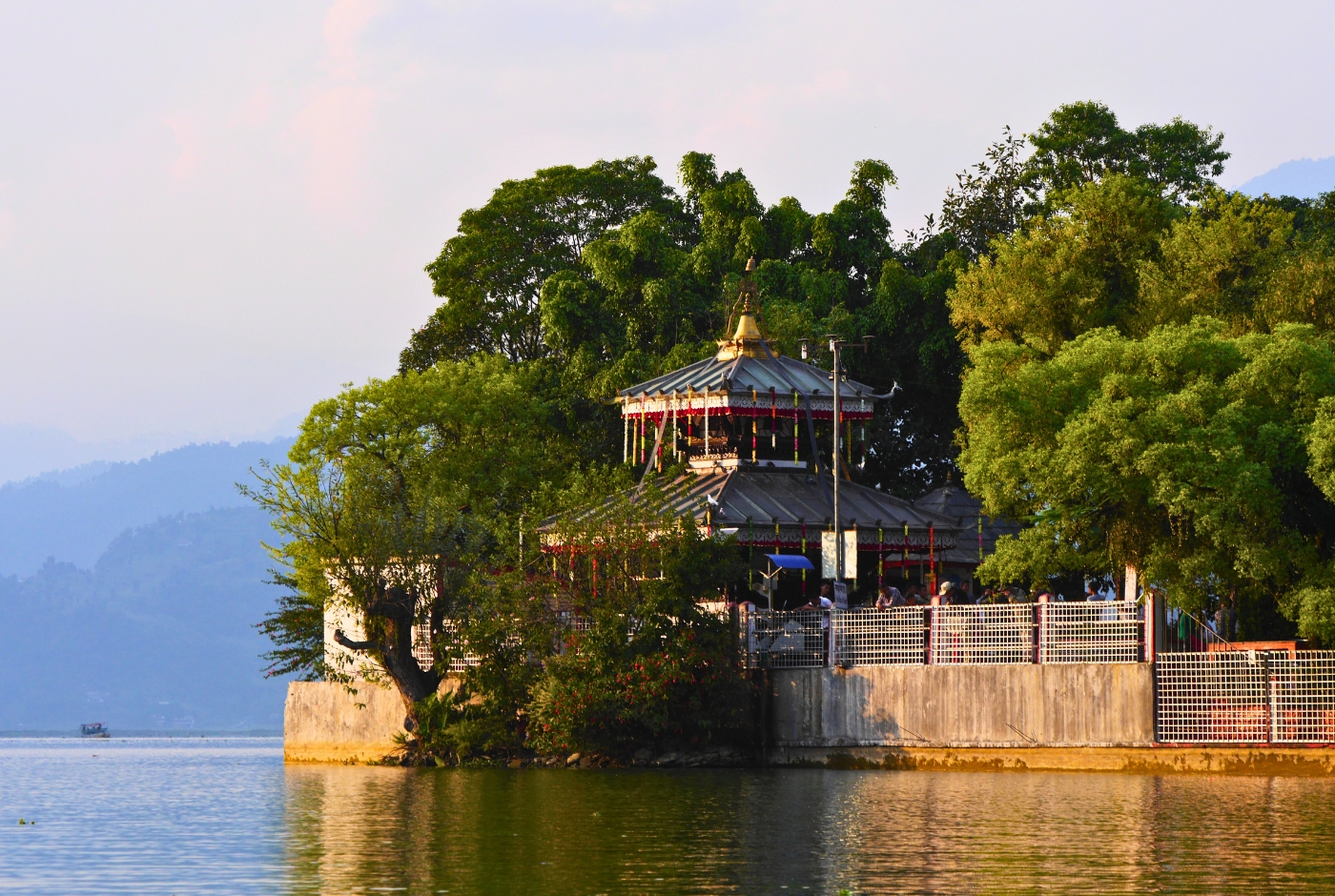
Davis Falls
Davis Falls, or Devi’s Falls, locally known as Patale Chhango (Underground Waterfall), is a captivating waterfall situated about 2 kilometers southwest of Pokhara. This natural wonder is renowned for its unique underground tunnel, where the water from a stream known as Pardi Khola cascades down and vanishes beneath the surface, creating a mysterious and enchanting spectacle.
The waterfall gained its name from a tragic incident in 1961 when a Swiss woman named Davi was swept away by the strong currents and drowned. In her memory, the site was named "Davis Falls."
Visitors can explore the nearby Gupteshwor Mahadev Cave, which is directly connected to the waterfall, offering a subterranean perspective of the cascading waters.
For those planning a visit, Davis Falls is open daily from 6:00 AM to 6:00 PM. One has to pay an entrance fee to get to the waterfall. The best time to experience the full splendor of Davis Falls is during the monsoon season, from June to September, when the water flow is at its peak.
Gupteshwor Mahadev Cave
The Gupteshwor Mahadev Cave, which stretches for about 2,950 meters, is Nepal’s longest cave. It is located in Chhorepatan, close to Davis Falls. Discovered in the 16th century, the cave has a natural Shivalinga considered sacred by Hindus.
The cave's entrance features a spiral staircase leading down to the main chamber. The staircase is decorated with beautiful sculptures and images of Hindu deities. Inside, explorers can observe impressive rock formations, including stalactites and stalagmites, as well as the thundering sound of water cascading down from the Davis Falls.
The cave is open for visitors from 6:00 AM to 7:00 PM. An entrance fee is charged to enter the cave. Some of the passages are quite narrow, slippery, and dimly lit. People who are claustrophobic may find it difficult to explore the cave.
Shree Bindhyabasini Temple
The beautiful Shree Bindhyabasini Temple sits atop a hill overlooking Pokhara Valley. The temple, dedicated to Goddess Bindhyabasini, is one of the city's ancient and revered Hindu pilgrimage sites. Established in the mid-eighteenth century, this sacred site serves as a significant spiritual center for both locals and visitors.
The temple's origin is steeped in legend. It is believed that King Siddhi Narayan Shah of Kaski envisioned the goddess in a dream, prompting him to commission a statue from Vindhyachal Parbat in present-day Uttar Pradesh, a north Indian state. While bringing back the idol of the goddess, it became immovable at a place where the palanquin bearers rested. The king interpreted this sign as the goddess's desire to reside there. So, the Bindhyabasini Temple was constructed on the very spot where the idol rested.
Built in the Shikhara style of temple architecture, the main shrine is surrounded by smaller temples dedicated to deities such as Saraswati, Shiva, Hanuman, and Ganesha. Devotees can access the temple via a stone staircase leading up the hill. A lift was installed in 2019 to make the temple accessible for the elderly and disabled devotees.
From the temple’s premises, one can enjoy panoramic views of the Himalayas and the Pokhara Valley. The temple is open for visitors from 5:00 AM to 7:00 PM. No entrance fee is required to visit the temple. However, visitors are expected to dress modestly and remove their footwear before entering the temple.
For those seeking spiritual enrichment and cultural immersion, Shree Bindhyabasini Temple offers a serene retreat.
Sarangkot
Sarangkot, a hilltop village close to Pokhara, is renowned as a prime viewpoint for breathtaking sunrise and sunset views over the Himalayan mountains. It is one of the most popular vantage points in Pokhara offering panoramic views of the snow-capped Annapurna Range and Dhaulagiri Himal. Perched on top of a hill, it is also a great destination for paragliding. The favorable wind conditions and expansive landscapes make it an ideal spot for both novice and experienced paragliders seeking an adrenaline-filled adventure.
For hikers, the ascent to Sarangkot is a rewarding experience. The most popular route, known as the South Trail, begins near Phewa Lake and involves a climb of approximately 610 meters over a distance of about 4 kilometers. This trek typically takes around 90 minutes to 2 hours, depending on one's pace, and offers scenic views of the surrounding villages and rural landscape.
Recently, a cable car service from Pokhara to Sarangkot has been introduced. This provides an alternative to the long hike and drive, making the viewpoint reachable in a short time. Whether one chooses to hike, drive, or ride the cable car, the experience of witnessing the majestic Himalayan ranges from Sarangkot is truly unforgettable.
For visitors planning a trip, it's advisable to arrive early in the morning to catch the sunrise, as this is when the mountains are visible before clouds gather later in the day. The village offers several guesthouses and eateries, allowing travelers to extend their stay and fully immerse themselves in the natural beauty and tranquility of the area.
Best Things to do in Pokhara: What to do in Pokhara?
Pokhara offers a range of activities suitable for families and friends, including scenic views, short treks, and water sports. Consider exploring the lakes by boat, hiking to viewpoints like Poon Hill or Sarangkot, or visiting the International Mountain Museum.
Mountain Viewing
You can begin your day by heading to Sarangkot to enjoy a mesmerizing sunrise over the Himalayan peaks. From the viewpoint, breathtaking views of more than twenty peaks, including Annapurna I, Annapurna South, Gangapurna, Hiunchuli, Baraha Shikhar, Lamjung Himal, Nilgiri, Machhapuchhre, and Dhaulagiri, can be savored.
You can witness the magical sight of snow-capped peaks bathed in the golden hues of dawn, creating a spectacular display of colors. This vantage point is easily accessible by a short drive or an invigorating hike from the city center.
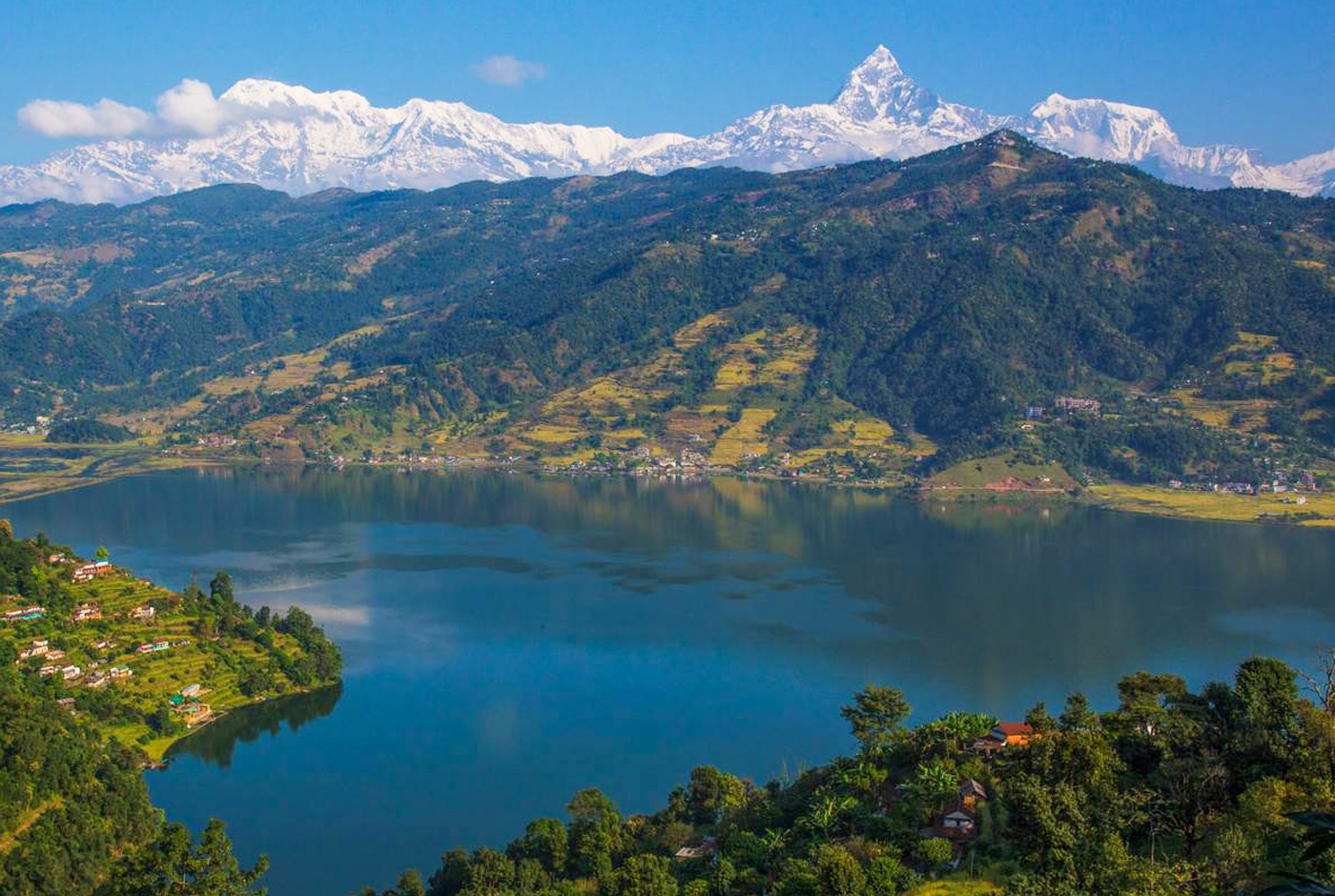
Boating and Kayaking
Pokhara is dotted with lakes where one can enjoy boating and kayaking. You can choose either Phewa Lake, Begnas Lake, or Rupa Lake for your water excursion. You can rent a traditional wooden boat, locally known as a "doonga," or opt for a kayak to explore the tranquil lakes. While boating on Phewa Lake, you can visit the Tal Barahi Temple, a two-story pagoda nestled on an island in the lake's center. The lakeside area is also dotted with cafes and restaurants, making it a perfect spot to relax and soak in the scenic beauty.
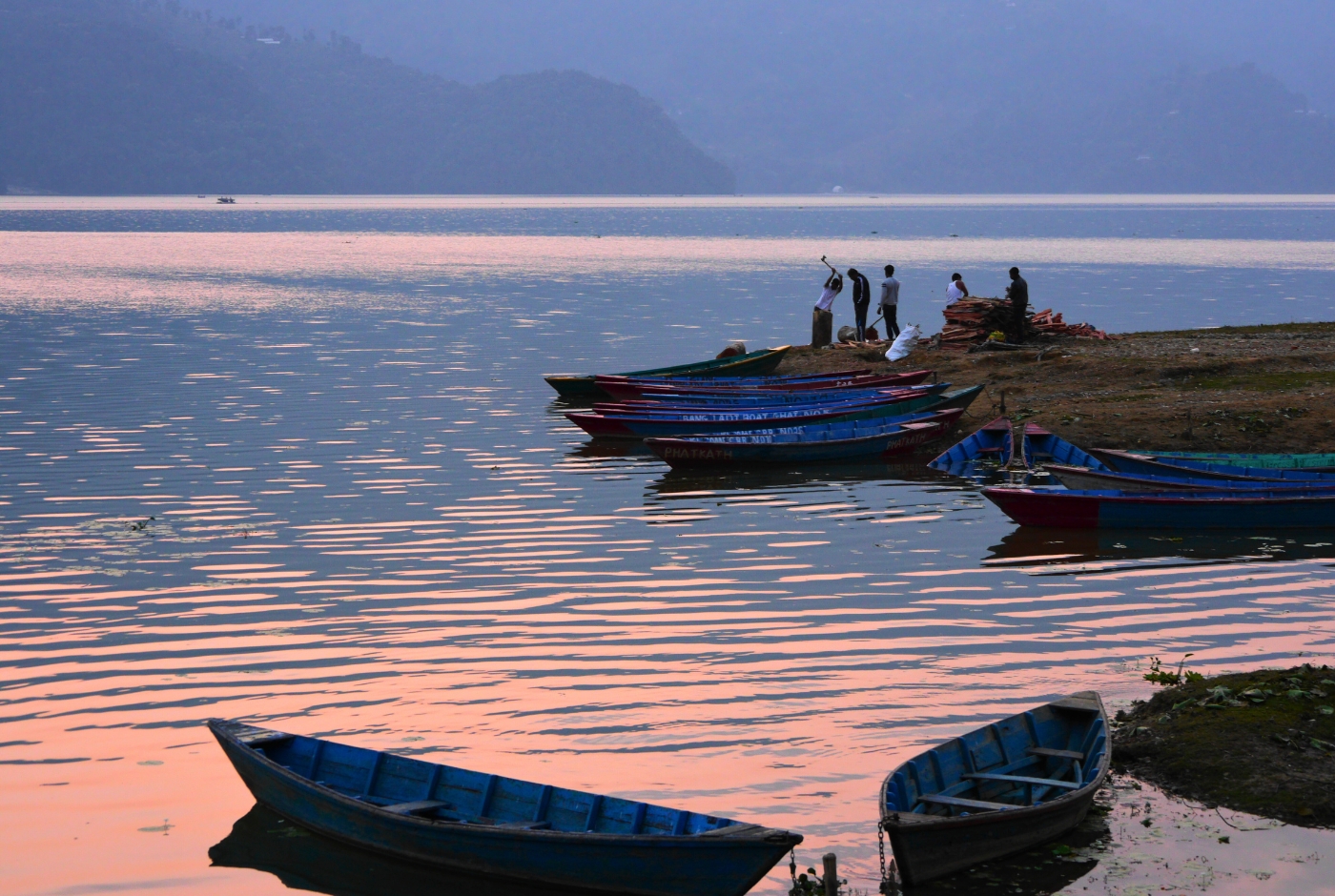
Paragliding
For thrill-seekers, paragliding in Pokhara offers an unparalleled experience. The launching pad for paragliding flights in Pokhara lies at Sarangkot. The top take-off destination sits at an elevation of 1,592 meters. You can enjoy a tandem flight with a pilot guiding the parachute above the valley, with the majestic Himalayas on one side and the serene Phewa Lake on the other. Tandem flights usually last for 20 to 30 minutes and are available for beginners. Flying with an experienced pilot ensures safety and protection. The best seasons for paragliding are from September to November and February to April, when the weather conditions are optimal.
Ultralight Flight
An ultralight flight takes you aboard a micro aircraft with an open cockpit. Ultralight aircraft are tiny and lightweight and are powered by a small engine. These micro aircraft offer you a great opportunity to fly above Pokhara and get a bird''s-eye view of its picturesque landscape adorned with verdant hills and tranquil lakes. It’s a fun and thrilling experience to fly above Pokhara in a mini plane.
The flight, flown by an experienced pilot, takes you closer to the Himalayas, offering a unique perspective of the peaks and valleys. The flight’s duration ranges from fifteen minutes to an hour and can reach speeds of 50 to 80 km/hr,
Ziplining
Pokhara is home to the longest and steepest zipline in the world. Known as the ZipFlyer, the zipline spans 1.8 kilometers and has a vertical drop of more than 600 meters. The zipline is built on a slope with an incline of 56 degrees. The starting point of the zipline is the Sarangkot Danda, which lies at an altitude of 1550 meters. The thrilling ride takes you past dense forests and paddy fields at a speed of around 100 km/hr. The majestic Annapurna Range can be seen rising in front of the zipline. The exhilarating ride ends at Hemja, which sits at an elevation of 950 meters above sea level. If you love the rush of adrenaline, you should certainly try this amazing ziplining experience in Pokhara.
Bungee Jumping
Bungee jumping is another thrilling adventure you can experience in Pokhara. The bungee site lies in a scenic location, surrounded by mesmerizing views of the Himalayan mountains. The bungee tower is suspended high above a river gorge from where thrill seekers are allowed to bungee jump (under expert supervision) and freefall down a steep cliff with an 80-meter drop.
This activity is designed for adventure lovers seeking an adrenaline-pumping free fall amidst stunning natural surroundings. The bungee site adheres to international safety standards, ensuring a safe and secure jump for all participants.
Skydiving
Skydiving is one of the premium adventure activities you can try in Pokhara. The drop zone is located in Pame Danda, a grassy field, surrounded by paddy fields, close to Phewa Lake. You will fly on a helicopter and skydive from a height of 11,000-13,000 feet. Freefalling from this height with the stunning Himalayan mountains rearing on the horizon is an experience you will remember forever. You can also enjoy a bird’s-eye view of Phewa Lake and Pokhara City while flying down to the drop zone. Tandem as well as solo skydiving are available. This activity is typically organized during specific seasons and requires prior booking.
Mountain Biking
Pokhara Valley is surrounded by small hills and villages that offer great opportunities for mountain biking. Some of the popular mountain biking tracks take you to Sarangkot Hill, Shanti Stupa, or Peace Pagoda, and around Phewa Lake. Some tours include overnight stays and e-bike options. Numerous trails cater to all skill levels, from leisurely rides around the lake to challenging routes that ascend to hilltop viewpoints. Rentals are readily available, and guided tours can be arranged for those unfamiliar with the area.
Hiking
The hills and small villages surrounding Pokhara serve as ideal destinations for day hiking. The hikes are short and last for half a day or about 3-4 hours. Some of the most popular day hikes in Pokhara are the Peace Stupa Hike from Phewa Lake, the Phumdikot Hike, the Naudanda Hike, and the Sarangkot Hike. The hiking trails take you past lush forests, paddy fields, and picturesque villages. You can also enjoy inspiring views of the Annapurna Range and other mountains from the hiking trails. You can do this hike by yourself or hire a local guide to show you the way and offer insights into the culture and history of the place.
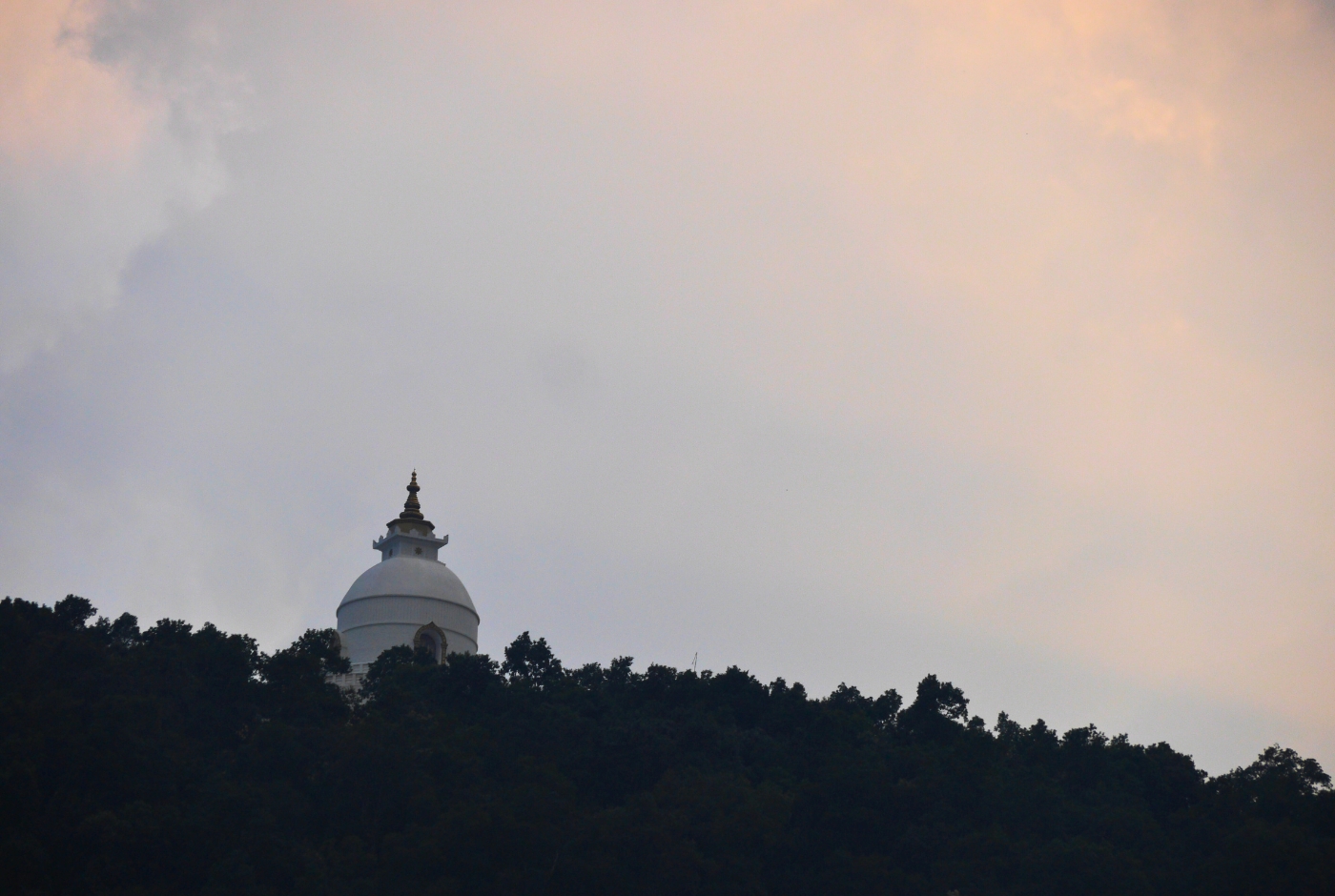
Birdwatching
For birdwatching enthusiasts, the dense forests and wetlands of Pokhara offer a great opportunity for birding tours. The lush forests surrounding Phewa Lake have a rich birdlife and are a great place to explore. The woods around Begnas Tal and Rupa Lake are also favorite haunts of some of the rare winged creatures like the Lesser whistling duck, spiny babbler, Indian Pond heron, Egyptian vulture, Himalayan Monal or Danphe, and many other varieties of birds. You can spot the birds on your own or take a birdwatching tour with an expert guide.
Pokhara has a Pokhara Bird Society, which offers birding tours and excursions around the birdwatching hotspots. Some of the spots you should not miss out on as an avid birdwatcher are the Ghachowk Vulture Restaurant, a community-managed feeding site for vultures, Dobhilla, and the Seven Lakes of Lekhnath.
Golf
For ardent golfers, Pokhara offers a 9-hole golf course in a stunning location. Located about seven kilometers from the main city, the Himalayan Golf Course sits above the Seti River canyon and offers a unique golfing experience. This 9-hole course challenges players amidst a raw and stunning landscape. Equipment rentals and caddies are available on-site.
Museum Tours
You can delve into the region's rich history and culture by visiting the museums in Pokhara.
International Mountain Museum: The International Mountain Museum showcases the culture of mountain communities, the geology of the Himalayas, and the history of mountaineering in the Himalayas. There are six galleries, a library, a climbing wall, a souvenir shop, and a restaurant inside the museum.
Gurkha Memorial Museum: This museum showcases the history of the brave Gurkha soldiers, whose courage and valor are renowned all over the world. The exhibits at the museum detail their history, achievements, and contributions. This is a must-visit site for people interested in military history and warfare.
Pokhara Regional Museum: The Pokhara Regional Museum offers valuable insight into the culture and traditions of indigenous communities inhabiting the Annapurna Region. Exhibits include traditional costumes, musical instruments, farming tools, utensils, pottery, and tableaus depicting shamanic rituals and traditional villages of different ethnic communities.
Annapurna Regional Museum: The Annapurna Regional Museum is run by ACAP (Annapurna Conservation Area Project). Exhibits at the museum include an amazing collection of insects, butterflies, and stuffed birds and animals found in this region.
What to do around the Lakeside of Pokhara? How to spend time in Pokhara Lakeside?
The Lakeside is a popular tourist hub in Pokhara. Stretching along the shores of the tranquil Phewa Lake, the Lakeside or Baidam area is a vibrant place lined with restaurants, cafes, hotels, and hostels. This is a great place for trekkers as well as other tourists to chill and spend their time blissfully in Pokhara.
Book a stay at the Lakeside
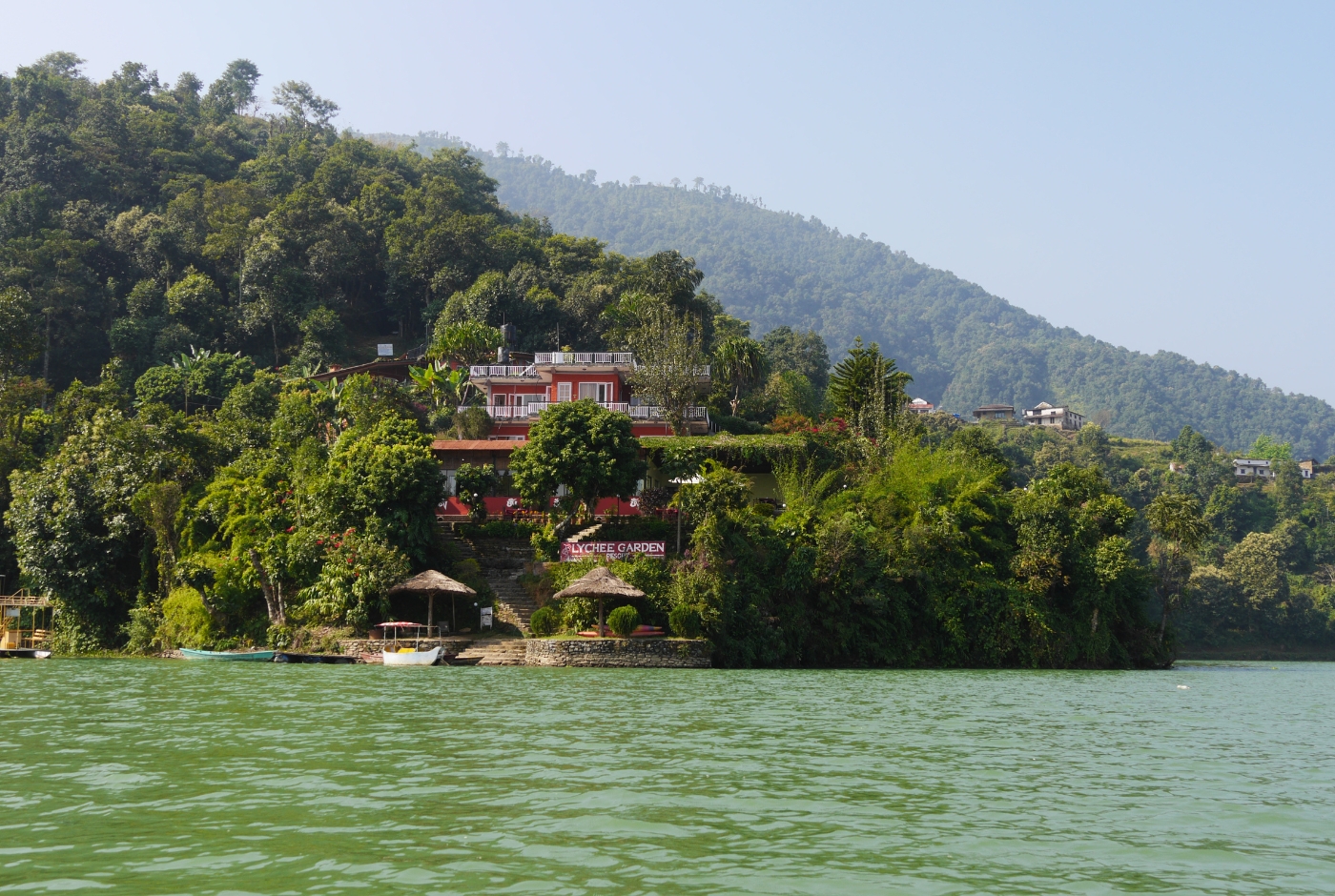
Lakeside offers a wide range of accommodations to suit various preferences and budgets. There are luxurious resorts and hotels for high-end tourists, as well as standard guesthouses and hostels for budget travelers and backpackers. Most of the hotels at the lakeside offer stunning views of Phewa Lake and the mountains.
Taste the culinary delights
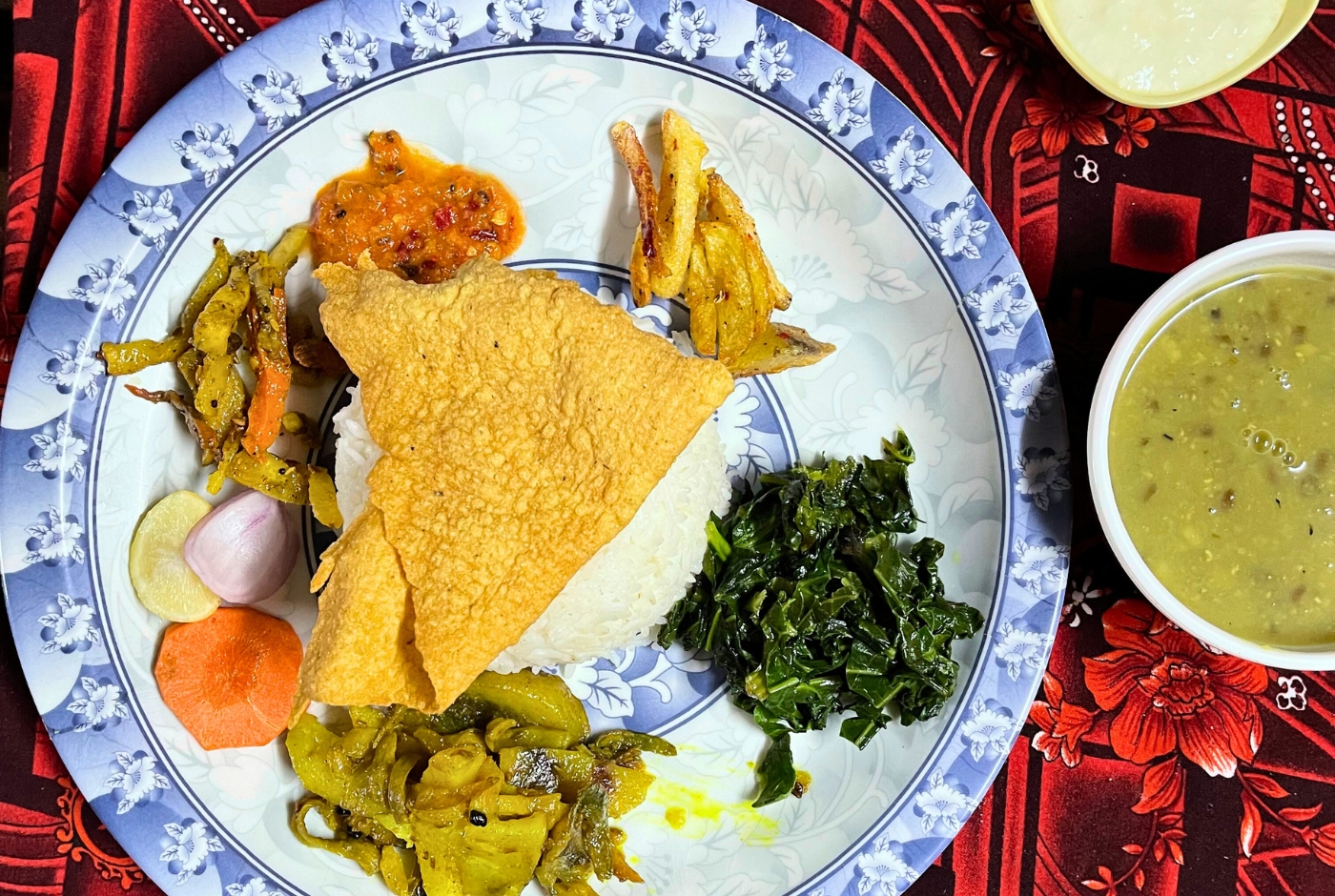
Fancy restaurants and cafes line the streets of the Lakeside. Since this area has the highest concentration of tourists, the eateries and restaurants offer an eclectic choice of food on their menu. Visitors can savor traditional Nepali dishes, Japanese sushi, a Chinese hotpot, Italian pasta, a Korean barbecue, or a mezze or Middle-Eastern platter.
Visit cultural and religious sites
One can visit the island temple of Tal Barahi by boat and offer prayers to the deity with other Hindu devotees. The Tal Barahi Temple, dedicated to goddess Barahi, lies on a small island at the center of Phewa Lake. The World Peace Pagoda, or Shanti Stupa, a Buddhist shrine is perched atop a hill above Phewa Lake. To hike to the stupa, you can take a boat ride to the opposite shore and hike from there to the top of the hill. From the stupa, you can enjoy mesmerizing views of Pokhara Valley, Phewa Lake, and the Annapurna mountains. Pumdikot Shiva Temple is another religious site you can explore by hiking from the Lakeside.
Try some outdoor activities
You can enjoy boating and kayaking on Phewa Lake. The forests surrounding Phewa Lake offer ample opportunities for nature tours and birdwatching tours. If you love cycling, you can rent a mountain bike and ride around the Lakeside and the hills surrounding the Phewa Lake. From Lakeside you can hike to Sarangkot or nearby villages and experience rural life.
Go shopping
The Lakeside is lined with shops selling souvenir items, trekking gear, and handicrafts created by locals. You can shop for souvenirs and gifts at these shops. Some of the items that tourists usually buy are traditional Nepali art, jewelry, decoration pieces, and clothes and footwear that are made in Nepal.
Have some fun at the amusement park
There’s a small amusement park by the Lakeside that offers some fun and interesting rides. There’s nothing more enjoyable than being a kid again and enjoying the delights of an amusement park. The heart-stopping rides on the Ferris Wheel and the giant Columbus Swing are quite popular among tourists.
Wellness and Relaxation
The serene and peaceful vibe at the Lakeside makes it an ideal spot for wellness activities. Numerous centers offer yoga and meditation sessions, while spas provide traditional massages and therapies, ensuring a rejuvenating experience amidst the tranquil backdrop of Phewa Lake and mountains.
Our Best Packages for the Pokhara Tour: Top Pokhara packages 2025
The beautiful natural landscape and the pleasant subtropical climate make Pokhara a favorite destination for tourists. It is less polluted and less crowded than Kathmandu, and with ample opportunities for outdoor activities, more visitors prefer spending time at the lakeside city than anywhere else in Nepal. If you would also like to experience the natural and cultural delights of Pokhara, you can check out some of the best-selling Pokhara tour packages designed by the Nepal Hiking Team for travelers like you. Pokhara City Tour, Kathmandu and Pokhara Tour, and Kathmandu, Pokhara, and Chitwan Tour are some of the best-selling Pokhara Tour packages.
If you wish to travel beyond the cities and explore the mountains, here is a list of popular trekking trails that lie close to Pokhara.



Post a Comment